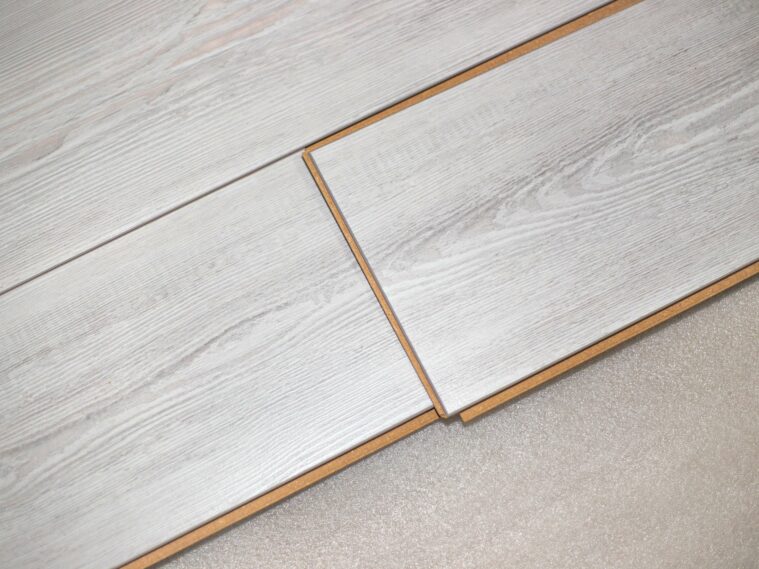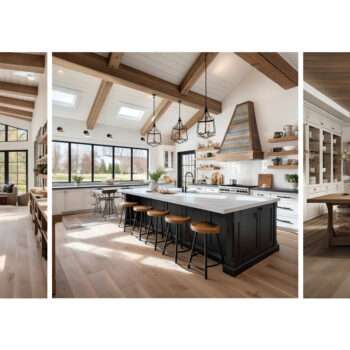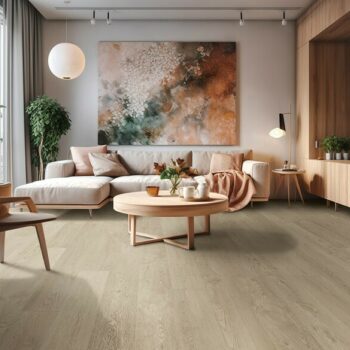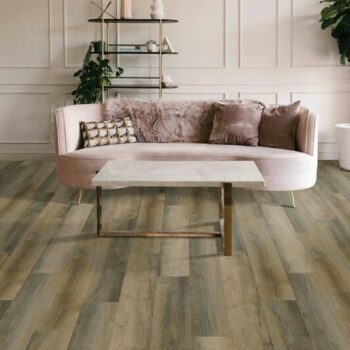
Why Does Vinyl Flooring Come in Different Thicknesses?
ShareWhen choosing new vinyl flooring for any room in your home, it’s important to consider appearance and performance equally.
If you are replacing the flooring in your kitchen, you may decide to install a thicker luxury vinyl tile (LVT). If you are updating the flooring in your guest bathroom, you may opt for a thinner luxury vinyl plank (LVP). The reason: the thicker the vinyl flooring, the more durable and comfortable it will be.
LVT is constructed of four distinct layers including:
- Urethane coating
- Protective wear layer
- Decorative film layer
- Solid vinyl base layer
How Is Thickness Measured in Vinyl Flooring?
Traditional glue down LVT thickness is typically measured in two ways — the overall thickness of the product and the thickness of the protective clear vinyl wear layer. The overall thickness correlates with a floor’s comfortability. It is measured in millimeters and ranges from 2mm up to 5mm overall thickness. Many times you will see thickness referred to as gauge. The thickness of the wear layer impacts the floor’s durability. It is measured in MIL and ranges in thickness from the thinnest residential wearly of 4 MIL to to thicker commercial grade wearlayers of 20 MIL or greater. A MIL equates to 1/1000 of an inch.
Choosing The Right Thickness
High-traffic areas that are frequently traversed by a house’s occupants or employees/customers in a business need to withstand sustained daily wear and tear. Installing vinyl flooring with the right amount of thickness can help ensure your floor will last for years to come.
When installing LVT/LVP residentially, consider using vinyl that has:
- An overall thickness of 2 – 2.5mm
- A wear layer thickness up to 12 MIL. 20 MIL is ok to install in homes, but it’s a little bit of overkill for residential applications.
If you plan to install more than one type of vinyl flooring, be sure to consider the transition from room to room. Avoid transitions from a thick vinyl floor to a thinner one as this creates an awkward and uncomfortable shift between spaces.
Is The Wear Layer or Overall Thickness More Important?
Think about why you are replacing your flooring. Are you upgrading your current flooring because it’s damaged or worn, or are you tired of the hard tile in the kitchen hurting your feet?
If you’re looking for practicality and a floor with lasting characteristics, it may be best to invest in greater wear layer thickness. The wear layer protects the decorative film to maintain the floor’s original look and provide a maintenance-free finish. If the wear layer isn’t thick enough in heavily trafficked areas, it eventually diminishes and exposes the decorative layer to wear and tear — which may lead to noticeable changes in the appearance over time.
For common gathering areas in your home like your living room, kitchen or playroom, the overall thickness of the flooring can make a huge difference. Although the overall thickness doesn’t affect durability, it does contribute to the ease and comfortability of standing or walking on the floor. Think of the overall thickness as additional support and cushioning in areas where you might need it most.
Does the Subfloor Make a Difference?
Believe it or not, the subfloor does make a difference in the vinyl flooring and thickness you choose. The subfloor is the foundation for the vinyl flooring and what you lay the vinyl across. It could be a concrete slab or existing hardwood or laminate floors.
Generally, a smooth and even subfloor is ideal for installing vinyl flooring. If the subfloor is sunken in and inconsistent in certain areas, it can alter the appearance and compromise the functionality of the new flooring. Most homeowners choose thinner vinyl with a concrete subfloor and thicker vinyl for tile or hardwood subfloors. If you’re not sure which one to choose, a vinyl flooring dealer can help.
How Important is Thickness with Rigid Core Waterproof Vinyl?
With rigid core waterproof vinyl floors, overall thickness as important as with traditional glue-down LVT/LVP. With these types of floors, much of the comfort underfoot is derived from the pad attached to the underside of the flooring which typically are either 1mm or 1.5mm thick. However, when it comes to wear layer thickness, the previously discussed guidelines for LVT/LVP also apply to rigid core waterproof vinyl.
Shop Residential Vinyl Flooring with Metroflor
Finding the perfect flooring for your home can be an intimidating process. At metroflor.com, our product lineup is easy to browse or you can filter options to drill down to products based on your own preferences. Once you’ve found an option or two that you like, we offer free samples mailed directly to you. This makes shopping for vinyl flooring a breeze so you can feel confident in your choice. Then when you are ready to buy, visit our dealer locator to find a nearby Metroflor retailer.
To learn more about our high-quality flooring products, browse our website or get in touch with a LVT and LVP flooring dealer near you.
Read the Latest Style News

Mar 15, 2024
Are There Different Types of Farmhouse Styles?

Feb 21, 2024
How to Bring Art into Your Living Spaces

